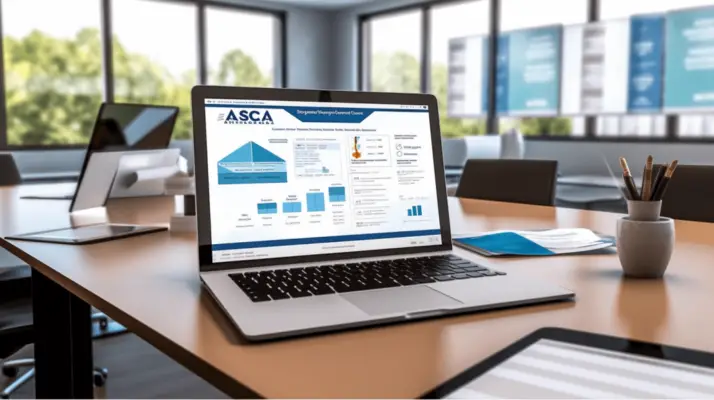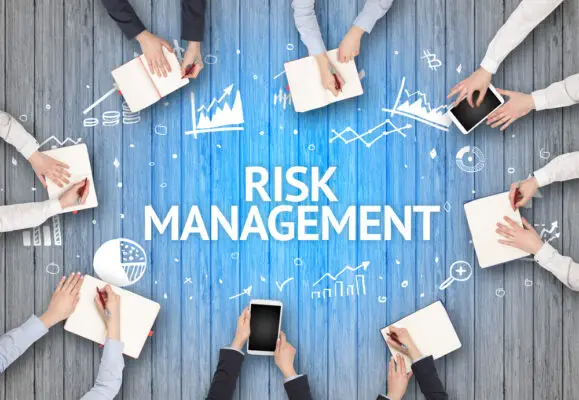A risk management report sample typically provides a structured document that outlines the results and summary of risk management activities within an organization.
It includes details on the risk assessment process, identification of potential risks, analysis of the likelihood and impact of these risks, and the measures taken to mitigate them.
For instance, a risk management report template provides key oversight of an organization’s risk management reporting functions and might include reporting on the status of key risks, actions taken, and an overview of the risk profile.
Another example includes a sample risk analysis report, which would typically reflect the results of risk factor identification and assessment, quantification of risks, and contingency analysis.

These reports are essential for communicating with stakeholders, like a board of directors, about the current risk landscape and the steps the organization is taking to manage risk effectively.
Risk management reports are essential for businesses of all sizes, providing a structured approach to identify, evaluate, and address risks through strategies like risk avoidance and mitigation.
These reports include key elements like risk identification methods, impact assessment techniques, and reporting with monitoring to enhance decision-making processes.
By exploring sample risk assessment templates and case studies, organizations can gain valuable insights into effective risk management practices to strengthen their resilience in handling uncertainties and emerging threats.
Key Takeaways
- In-depth risk assessment methodologies.
- Comprehensive risk mitigation strategies.
- Detailed risk impact analysis.
- Effective risk monitoring techniques.
- Clear and concise risk reporting formats.
Importance of Risk Management Reports
Risk management reports play a pivotal role in organizations by outlining risk mitigation strategies and providing support for decision-making processes.
These reports offer a structured approach to identifying, evaluating, and addressing potential risks that could impact the business.
Risk Mitigation Strategies
Effective risk mitigation strategies are essential components of thorough risk management reports for businesses of all sizes.
These strategies aim to identify, assess, and prioritize risks, followed by implementing measures to minimize, monitor, and control them.
Common risk mitigation strategies include risk avoidance, where the business chooses not to engage in high-risk activities, risk reduction through implementing safety measures, risk transfer by purchasing insurance, and risk acceptance for risks deemed unavoidable or too costly to mitigate.
Decision-making Support
In the domain of business operations, well-crafted risk management reports play an essential role in providing decision-making support by offering valuable insights into potential threats and opportunities.
These reports enable stakeholders to make informed decisions that can help mitigate risks and capitalize on emerging possibilities.
By presenting data in a structured manner, risk management reports aid in understanding the current risk landscape and assist in prioritizing actions to address these risks effectively.
The table below illustrates the types of decision-making support that can be derived from thorough risk management reports.
| Decision-Making Support | Description |
|---|---|
| Risk Identification | Identifying and evaluating potential risks. |
| Opportunity Analysis | Assessing potential opportunities for growth. |
| Risk Prioritization | Ranking risks based on impact and likelihood. |
Key Elements of a Risk Report
The key elements of a risk report include:
- Risk identification methods.
- Impact assessment techniques.
- Risk mitigation strategies.
- Reporting and monitoring.
These components collectively form the bedrock of a thorough risk management strategy, aiding organizations in understanding, addressing, and minimizing potential risks.
Risk Identification Methods
Identifying risks is a fundamental aspect of compiling a thorough risk management report. There are various methods used by organizations to identify potential risks.
One common method is the brainstorming technique, where team members come together to generate a list of possible risks based on their expertise and experience.
Another method is the use of checklists and historical data to identify risks that have occurred in similar projects or situations.
Additionally, interviews with stakeholders, conducting risk surveys, and utilizing risk assessment tools can help in identifying risks that may impact the project or organization.

Impact Assessment Techniques
Effectively evaluating the potential consequences of identified risks is crucial in developing a thorough risk management report.
Impact assessment techniques serve as valuable tools in this process, aiding in understanding the severity and implications of various risks on the organization.
Common techniques include qualitative assessments, which involve evaluating risks based on predefined criteria, and quantitative assessments, which assign numerical values to risks for better comparison.
Scenario analysis is another technique where different risk scenarios are explored to gauge their potential impact.
Sensitivity analysis helps in understanding how changes in variables can affect risk outcomes.
By utilizing these techniques, organizations can gain a holistic understanding of the potential impacts of identified risks, enabling them to make informed decisions and develop effective risk mitigation strategies.
Risk Mitigation Strategies
Utilizing evaluation techniques to understand the severity and implications of identified risks is fundamental in developing effective risk mitigation strategies within a thorough risk management report.
By analyzing the potential impact of risks, organizations can proactively implement strategies to minimize the likelihood of these risks occurring or reduce their negative consequences. Below is a table outlining common risk mitigation strategies:
| Risk Mitigation Strategy | Description |
|---|---|
| Risk Avoidance | Involves eliminating the risk by avoiding the activity that could lead to it. |
| Risk Reduction | Focuses on decreasing the probability or impact of the risk. |
| Risk Transfer | Involves shifting the risk to a third party, such as through insurance. |
| Risk Acceptance | Acknowledging the risk and choosing to deal with its consequences if it occurs. |
Reporting and Monitoring
An integral aspect of a thorough risk management report is the meticulous documentation and vigilant oversight of potential risks through exhaustive reporting and monitoring.
Reporting involves the detailed analysis and presentation of risk data, highlighting areas of concern and potential vulnerabilities.
Monitoring, on the other hand, requires continuous tracking and evaluation of identified risks to guarantee prompt responses and effective risk mitigation strategies.
By implementing robust reporting mechanisms and establishing regular monitoring practices, organizations can proactively identify, assess, and address risks before they escalate into significant threats.
This systematic approach not only enhances risk awareness but also enables informed decision-making and the timely implementation of corrective actions to safeguard business operations and objectives.
Sample Risk Assessment Template
The sample risk assessment template includes key risk factors and mitigation strategies to help organizations identify and address potential threats to their operations.
By outlining these factors and strategies, businesses can proactively manage risks and protect their assets.
Implementing a structured risk assessment template enhances decision-making processes and promotes a culture of risk awareness within the organization.
Key Risk Factors
Identifying and analyzing key risk factors is vital in developing an effective risk assessment template for thorough risk management.
Key risk factors are elements or situations that could potentially jeopardize the achievement of a project or business goal.
These factors can vary widely depending on the nature of the project or industry but commonly include financial risks, market competition, regulatory changes, and technological disruptions.
By thoroughly understanding and documenting these key risk factors, organizations can proactively plan for potential challenges, allocate resources efficiently, and implement strategies to minimize negative impacts.
Regular review and updates to the list of key risk factors are essential to make sure that risk management efforts remain relevant and effective in addressing potential threats.

Mitigation Strategies
Developing effective mitigation strategies is essential for organizations to proactively address potential risks identified in the risk assessment template.
These strategies aim to reduce the likelihood of risks occurring or minimize their impact if they materialize.
Mitigation strategies can include implementing robust security protocols, conducting regular training sessions for employees, diversifying supply chains, creating backup systems for critical operations, and establishing emergency response plans.
By identifying vulnerabilities and formulating tailored mitigation strategies, organizations can enhance their resilience against various risks.
Continuous monitoring and periodic reviews are critical to guarantee the effectiveness of these strategies and adapt them to evolving threats.
Mitigation strategies play a significant role in safeguarding organizational assets and maintaining operational continuity in the face of uncertainties.
Case Studies in Risk Management
Effective risk management hinges on the meticulous analysis and application of proven strategies in real-world scenarios. Examining case studies provides valuable insights into how organizations navigate challenges.
For example, Company X faced a supply chain disruption due to a natural disaster. By having a robust risk management plan in place, they quickly identified alternative suppliers, mitigating the impact on their operations.
In another case, Company Y encountered a cybersecurity breach that threatened sensitive data.
Through proactive risk assessment and cybersecurity measures, they were able to contain the breach and strengthen their defenses.
These real-life examples demonstrate the importance of proactive risk management and the effectiveness of implementing strategies to mitigate potential risks.
Tips for Effective Risk Reporting
To effectively report risks, it is essential to employ clear communication methods that ensure stakeholders understand the potential threats. Utilizing visual aids, such as graphs or charts, can help convey complex information in a more digestible format.
Clear Risk Communication Methods
Clear and concise risk communication is essential for effective risk reporting in any organization. When communicating risks, it’s vital to use simple language that is easily understandable by all stakeholders.
Avoid jargon and technical terms unless explaining them is necessary.
Clearly outline the nature of the risk, its potential impact, and the actions being taken to mitigate it. Utilize multiple communication channels such as emails, presentations, or reports to guarantee the message reaches all relevant parties.
Tailor the communication style to the audience, providing detailed information to management while summarizing key points for other team members.
Utilize Visual Aids
Employing visual aids is a vital approach to enhance the comprehensibility and impact of risk reporting within an organization.
Visual representations such as graphs, charts, and diagrams can simplify complex data, making it easier for stakeholders to grasp key information at a glance.
These aids can help in identifying trends, patterns, and outliers, enabling more informed decision-making processes.
When utilized effectively, visual aids not only improve the clarity of risk reports but also enhance their overall effectiveness.
It is essential to choose the right type of visual aid that aligns with the nature of the data being presented and the intended audience.
Visual aids should complement the written information, providing a visual summary that reinforces the key messages being conveyed.
Regular Stakeholder Updates
For effective risk reporting, providing regular updates to stakeholders is essential in maintaining transparency and ensuring informed decision-making within the organization.
Regular stakeholder updates help in keeping all involved parties informed about the current status of risks, mitigation strategies, and any emerging issues that may impact the project or business.
Frequently Asked Questions
What Are the Common Challenges Faced When Implementing Risk Management Reports in an Organization?
Implementing risk management reports in organizations can face challenges like data accuracy, stakeholder alignment, and resource constraints.
Ensuring consistent data collection, engaging key stakeholders, and allocating adequate resources are essential for successful implementation.
How Can Organizations Ensure That Risk Management Reports Are Effectively Communicated to All Stakeholders?
Organizations can guarantee effective communication of risk management reports to stakeholders by utilizing clear and concise language, incorporating visual aids for better comprehension, scheduling regular updates and feedback sessions, and establishing a designated communication protocol for dissemination.
What Are Some Best Practices for Continuously Monitoring and Updating Risk Management Reports?
Continuous monitoring and updating of risk management reports require regular review of data, identification of emerging risks, and collaboration among stakeholders.
Utilizing technology for real-time tracking, engaging in regular risk assessments, and fostering a culture of risk awareness are key best practices.
How Can Organizations Measure the Effectiveness of Their Risk Management Strategies Based on the Information Provided in the Reports?
Organizations can measure the effectiveness of their risk management strategies by analyzing key performance indicators, conducting regular risk evaluations, tracking incident response times, evaluating the alignment of risk strategies with business objectives, and soliciting feedback from stakeholders.
What Are Some Emerging Trends or Technologies That Are Impacting the Field of Risk Management Reporting?
Emerging trends in risk management reporting include the adoption of advanced analytics, AI, and machine learning for more accurate risk assessments.
Blockchain technology is also revolutionizing data security and transparency in risk management processes.

Conclusion
In summary, risk management reports play a vital role in identifying, evaluating, and mitigating potential risks within an organization.
By including key elements such as risk assessments, case studies, and effective reporting tips, businesses can better understand and manage risks to achieve their objectives.
Organizations need to prioritize risk management and utilize thorough reports to guarantee the sustainability and success of their operations.

Chris Ekai is a Risk Management expert with over 10 years of experience in the field. He has a Master’s(MSc) degree in Risk Management from University of Portsmouth and is a CPA and Finance professional. He currently works as a Content Manager at Risk Publishing, writing about Enterprise Risk Management, Business Continuity Management and Project Management.

